by Winding Pathways | Dec 26, 2019 | Birds, Mammals, Nature, Reflections/Profiles
We asked readers to send along some curious animal encounters.
Enjoy these guest blog entries as we wind down 2019.
From the East Coast to the Upper Midwest and ranging to Alaska and Hawaii people interact with or encounter wildlife in rural and urban areas.
Birds
SF: Lots to Raven About. “I saw my first ever raven yesterday — sitting and cawing on the roof of a car in a parking lot in Milford! JEESH! Do you think it was a portent of anything?
“Crows, of course, are extremely common; nevertheless, I love to see them in the huge groups they tend to gather in. I don’t know who assigned the collective nouns for species, but “Murder of Crows” is a favorite.
“Every time I hear that “caw” I look up hoping to see a raven, but I’ve never seen one until yesterday. I heard a ruckus as I got out of my car in a parking lot in Milford, NH, and saw one — sitting on top of a car and making his presence known. It was huge and oddly majestic, but sadly, it was a single bird, not an ‘unkindness of ravens’.”
AS: Birding Resort. Happenings were just ducky at a Hawaiian resort. And, this cock had something to crow about following a skeptical tourist. Who won? “The rooster lives near the food truck so it wins this match off.”
-
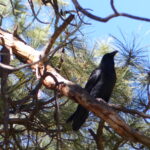
-
Ravens are huge and oddly majestic.
-
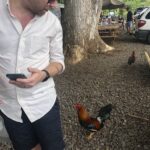
-
This rooster makes off great living near the food truck.
-

-
This duck wandered around the swimming pool at a Hawaiian resort.
JH: Eagle Encounter: Several years ago on my way to the Y swim class, I saw, to my total delight, a wondrous sight. As I approached my turn, I saw a huge bird just sitting on a fence post. I made the turn and slowly stopped my car, I recognized this critter as the American Bald Eagle. We each sat on our own perch eyeing one another. After carefully retrieving my camera, I snapped a couple of pictures.
The eagle kept an eye on me. Then, he spread his wings and laboriously lifted off, swinging to his left towards a telephone pole out in the pasture. As he landed, he tucked his wings into his sides and continued his watch. I suppose he was wondering what I was doing just as I was wondering what he had been doing as he sat on the fence post.
He had been just a couple of arm’s lengths from me. To be so close to him was awesome. I could only imagine what it would be like to stroke his beautiful feathers.
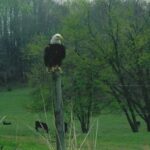
The eagle continued to eye me.
Mammals
JA: Albino deer. I caught some photos of albino deer in Wisconsin.
DP: Surprise Dolphins. “While reporting from Charleston, South Carolina, during the 2012 presidential campaign my colleagues and I stopped to look at the ocean. The city is surrounded on three sides by water and we expected to see lots of boats and people enjoying the water. We didn’t expect to encounter a school of dolphins! They swam around us for a few minutes and seemed to be having a lot more fun than we were.”
-
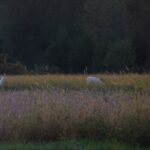
-
Two albino deer in a field.
-
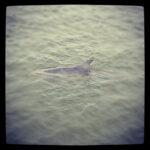
-
Dolphin in a harbor.
NP&BO: Moose & Wolverines & Cats! Oh, my! Baby moose roaming an Anchorage neighborhood, munching on raspberry patches. Then, along comes mama and they stroll down the street. A lot of urban moose in Anchorage. Other parts of the city boast moose and black bears!
News from the North. Latest Anchorage crime as reported by the Anchorage Daily News: Yet Another Urban Wildlife encounter as cat survives wolverine attack near the Campbell Science Center.
-
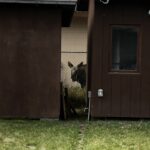
-
A curious calf moose looks across the lawn.
-
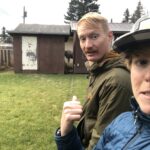
-
Munching raspberry bushes in the back yard.
-
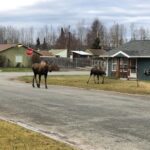
-
A curious calf moose looks across the lawn.
-
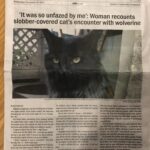
-
Strange things are seen in the land of the Midnight Sun.
North Woods Near Encounter
MN: Wolf Encounter. “My friend and I were camping in the BWCA in January, several years ago. At the end of a long day of cutting/splitting wood, fishing, snowshoeing and cutting more wood, we sat next to a blazing fire as the early sunset arrived and we were soon enveloped in darkness. The stillness of the forest in winter is amazing because there are no insects or other nocturnal creatures that make noise. On this windless night, there was no sound besides the crackling fire. Suddenly and without warning, we both had the feeling that someone or something was watching us from not far away. I slowly turned, and the fire was just bright enough to illuminate the face of a large wolf, 10 feet away. We froze, not knowing what to do. Had it been a black bear in summer, we would have started shouting and waving our arms to scare it away. But we weren’t prepared for this and had no idea what to do. So we just sat and watched. The wolf didn’t seem aggressive, and it slowly moved directly toward me. I remained motionless. It came right up next to me and sniffed my arm. I wondered, what I should do? I was a little too unnerved to do anything. The wolf seemed satisfied with my scent and moved on to my friend and smelled his boot. And then, just as quietly as he arrived, he slowly walked off into the woods. We sat there motionless, except for our eyes, all four of which were now the size of half dollars. We threw some more wood on the fire and waited, but the wolf did not return.
Mystery Solved
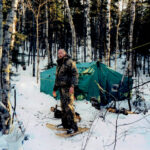
Comfortable digs on a winter campout.
“The next morning we got up and went out to fish. In the distance, on the other side of the lake, we saw someone doing the same. We decided to take a walk and share our wolf experience with this person. We greeted him and explained what happened and asked if perchance he had encountered the same wolf. He had indeed! And suddenly the wolf was bounding across the ice, coming straight for us. “Max, come on boy! Over here!” We were astounded that this guy was actually naming and calling wolves. “Do you know this wolf?”, we asked. He knew him all right. He owned this “wolf”, which was actually a mix – half-wolf, half-dog! We petted him and he licked our bare hands just as any dog would, especially since he was familiar with our scent after his visit to our campsite the previous night.”
Erma Herman Visits During a Cold Canadian Night
LF: Erma Herman. Though not snuggly, ermine are quite lovely little critters. Their Winter coat seems more purely white because of their black tails, bright black eyes and button nose. For several Winters I’ve enjoyed watching one that has visited our platform feeder to gnaw on the chunk of suet I put out for the birds. I marvel at the rapid movement, dashing back and forth, here one second, gone in a flash.
I’m guessing it’s one, as I’ve never seen two at the same time.
Last Winter, during a freeze/thaw period, after we had some plumbing issues that involved the plumber working in the crawl space under the house, we were visited by ‘Erma Herman’ in the middle of the night. I awoke to an alarmingly loud, squeaking/squealing sound coming from the kitchen and the cat “tharumping” across the floor, coming to a halt in front of the dryer, where I could see a tiny black nose poking out from underneath.
It had found its way in through the smallest of openings left by the plumber, making its way up the hoses for the washing machine and into the kitchen where the scent of cat food was calling. It took several nights, a mousetrap, which is still somewhere in the understructure of the house, several packages of steel wool and a roll of duct tape (Red Green would be proud) before it stopped coming in.
My neighbour, who no longer tries to keep chickens, is not a big fan of ermine, Winter or Summer.
-
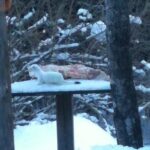
-
An Ermine climbed up and began gnawing on suet.
-
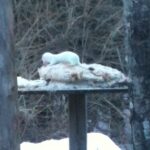
-
A white Ermine on the sudet feeder in Canada.
by Winding Pathways | Dec 12, 2019 | Birds, Chickens, Nature
As autumn progresses in the upper Midwest, birds appear and disappear, group and spread out. Pileated woodpeckers have returned to the suet feeders. Chickens help grind up the garden residue and eat the bugs. White-throated sparrows sing a different tune on their way south. Juncos suddenly appear. Bluebirds sit on branches surveying the yards. Hawks send everyone scurrying. Vultures wing one more time overhead before catching the north winds and head to warmer climes.
Watch these robins enjoying a sunny day bath.
-
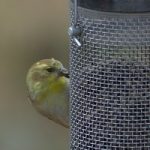
-
Songbirds appreciate high quality seed to sustain them in winter.
-
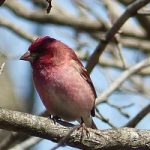
-
Some birds homestead at Winding Pathways.
-
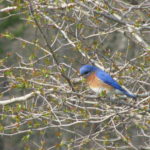
-
Bluebirds hang out on branches.
-
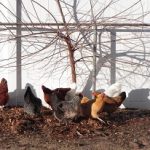
-
Chickens grind up garden residue.
-
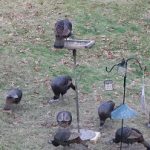
-
Turkeys and squirrels would make short work of seed, leaving none for the small birds.
-
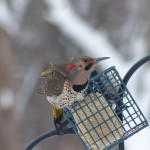
-
Winter is tough on birds so keep your feeders full.
-
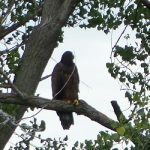
-
Fledgling eagle resting in the back yard.
-
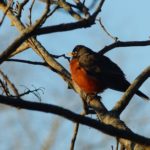
-
A robin surveys the area
by Winding Pathways | Nov 21, 2019 | (Sub)Urban Homesteading, Birds, Foraging, Garden/Yard, Nature, Trees
A New World Thanksgiving
Almost every meal Americans enjoy comes from animals and plants that trace their origin to many continents.
Cattle, sheep, chickens, and pigs, for example, are all natives of the Old World brought to America soon after it was settled by Europeans. Wheat, rice, and many other plant foods are also newcomers that were unknown to Native Americans.
One annual feast mostly made from original American foods is Thanksgiving. This year why not create this traditional feast from entirely plants and animals that were found here before Columbus?
Turkeys
Turkey highlights the Thanksgiving dinner. See our previous blog on this amazing and tasty bird. Here are plants native to North and South America to complement roast turkey:
Fruits and Vegetables
Corn: Corn has been grown in Central America for thousands of years. It’s cultivation gradually spread north and east and became a staple food for Native Americans. When hungry Pilgrims landed in what became Massachusetts they found and stole caches of corn stored by local tribes, no doubt causing bad feelings.
Cranberries: Most commonly eaten fruits originated in Europe or Asia, but the cranberry is an American native.
Squash and Pumpkins: Dozens of varieties of winter squash come in many shapes, colors and sizes, and the pumpkin is actually a squash. Butternut, Hubbard, acorn, or any other squash is delicious on the Thanksgiving dinner table, and dessert of pumpkin pie rounds out a tasty meal.
Potatoes: Common potatoes also originated in South or Central America and have been an important food for thousands of years. Mashed or baked, they go well with turkey, squash, and cranberries.
Sweet Potatoes: Originally from South America, these are among the most nutritious of foods. Similar yams have an African origin, so for a local dinner stick with sweet potatoes.
The sweetness from the Maples
Maple Syrup: While honey is made by bees that came from the Old World, maple syrup is America’s sweetener. It’s delicious on squash or sweet potatoes.
Beans: Native American gardens usually featured three plants: beans, squash, and corn. Commonly called The Three Sisters combined they create a balanced diet.
A diet of many foods that originally came from the Americas makes a delicious an interesting Holiday meal. We tend to thank modern geneticists for creating abundant food, but beans, corn, squash, sweet potatoes, maple syrup, cranberries, and turkey were all domesticated and enjoyed by Native Americans long before Columbus set sail.
-

-
Cranberry Pie brightens any Thanksgiving table.
-
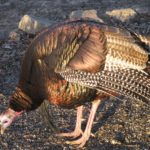
-
Cook Wild turkey differently than domesticated ones.
-
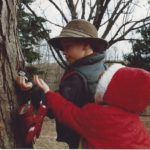
-
Maple syrup can sweeten many Thanksgiving meals.
by Winding Pathways | Sep 12, 2019 | Birds, Nature
Swapping Birds
All summer we’ve watched and listened to wren couples who built nests and raised young in our yard. An Indigo Bunting welcomed each summer morning with his song and serenaded the evening until dark. Early this spring, we marveled at the brilliantly colored orioles and grosbeaks who visited. During warm months, hummingbirds flitted up and down and all around outside our windows.
When a long-absent bird suddenly makes its springtime appearance in full breeding color, it’s exciting and easy to spot. We greet spring’s migrants after their long journey north with a hearty, “Welcome Home!” and some seed.
With fall now in the air, our vivacious summer bird friends are drifting away, pushed southward by vigorous north winds. Departure is different from arrival. When they appear in spring, birds are in their glorious mating colors and sing with gusto. They’ve been absent for months until one morning we look out the window – and there they are! It’s magical.
Indigo Buntings and Wrens Leave…
Arrivals are easy to mark. No so departures. By fall many birds have molted into their more subtle nonbreeding colors and just seem to evaporate. No singing marks their departure and figuring out just when they leave is challenging. More often we just say, “Gee, I haven’t heard the indigo buntings for a few days. I bet they’ve gone.”
…and Juncos Arrive
We wish we could help migrants on their departure evening by saying, “Have a safe trip and pleasant winter. See you next spring!” Since we don’t know exactly when they’ll be winging south, they depart without our good wishes. The parting is sad, but we know we’ll soon look out the window and almost miraculously spot the fall’s first juncos nosing around on the ground looking for a few seeds to enjoy for breakfast.
-
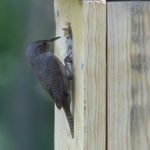
-
Wrens busily feed their young and sing all summer
-
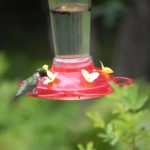
-
Hummingbirds zoom up, down, and sideways all summer. Then, head south.
-
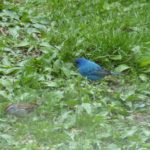
-
Indigo Bunting and Chipping Sparrow feeding.
Orioles and grosbeaks drift south starting in late summer and our bunting was gone by August 20. Hummingbirds and wrens disappear by late September. Juncos usually appear from northern breeding grounds in October and stick around until April. Then they seem to vanish overnight. But, that’s just before spring’s colorful songsters arrive
by Winding Pathways | Aug 29, 2019 | Birds, Bugs, Flowers/Grasses, Garden/Yard, Nature
On a sunny, warm, late summer day we watched countless bees and butterflies foraging on prairie plants, hummingbirds sipping nectar from Cardinal flowers, and small birds pausing to drink water on the cup plants. That evening, bats swooped across the sky as clouds gathered. Then, came the downpour.
So, we wondered, where do birds and bees and bats go during storms or just to rest? A bit of Internet searching yielded some fascinating information.
Bees
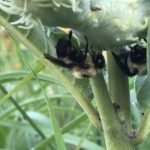
seeking shelter from the rain
Bees are active in the day and need sleep just like humans do. How they sleep is quite different. Bees and many insects do not have eyelids. They relax the body and antennae and sometimes fall over. Sometimes, the other bees in a honeybee colony prop up the “sleeping” bee. As we see in this video, and similar to human babies, they sleep in shorter bursts. This sleep helps their memory. Remember, bees, especially honeybees explore new foraging spots, return to the hive, communicate through a “dance” telling other bees where the source of nectar is. As with people, good sleep helps them perform better. Look for bees on the underside of leaves and grass blades after a rain or in the early morning.
Butterflies
Butterflies also seek shelter on the underside of leaves or grass blades. This vegetation protects them from furious winds and debilitating raindrops. Think about it! How delicate a butterfly’s wings are and how a large raindrop can punish it. A Scientific American article gave a great comparison to us humans – being whacked by a water balloon twice the mass of a bowling ball!
Birds and Bats

One hummingbird fell into a torpor on the feeder!
To rest, Hummingbirds go into torpor – a sleep-like state where the body temperature drops to conserve energy. They sometimes hang upside down as we see in this video. When the temperatures rise, they “wake up”. They can fly in moderate rains.
Some larger birds, like turkeys, actually come out in rainstorms and forage on insects that are slowed down by the cooler temperatures. At night, turkeys roost in trees. Watching them navigate through dense forests into the tops of sturdy trees is amazing.
Nighthawks, along with their nocturnal companions bats, find daytime shelter on tree branches. Bats tuck under tree bark flaps, in crevices and caves, and enter tiny cracks in homes making attics a cozy den.
Next time you are out and about, look carefully on undersides of leaves and grass blades, study branches of trees for unusual shapes that might be a roosting bird, and notice animals out and about at different times of the day and in different weather.
by Winding Pathways | May 23, 2019 | Birds, Nature
A Tale of Baby Owls
Guest Blogger, R’becca Groff
The first sign of an owl living back on our acreage happened late last summer when I heard a rabbit being taken late one night. A rabbit sounds like a human baby when it’s in trouble, and it is the painful reality of the food chain.
Throughout this past winter, my neighbors and I have been listening to two owls living across our adjoining properties – a very large one and his smaller mate — we assumed.
I was the only one who wasn’t getting outdoors in time to see them, however.
The other day I heard the hooting midday and ran outside, determined to see where this owl was perched. It sounded so close to my office window. And there it was…staring down at me from one of the old Austrian pine trees between my house and my neighbor’s.
I spoke softly to it, hoping it wouldn’t mind but it wanted nothing to do with me, and promptly vacated its branch perch, gliding gracefully across my neighbor’s back yard to a safer distance.
As I’d been hearing about a huge hawk nest way at the back of our property line, I went to have a look for myself. Studying the tree line as I walked, I came upon an owlet watching down from one of the lower branches of another pine tree. I couldn’t resist it. I had to try and converse with this beautiful creature. It sat there watching back at me, unhinged by my presence. Just for fun, I circled the tree, and the baby followed my every move.
Of course, I texted the neighbors, only to learn there are two new owlets as my northern neighbors have been watching that hawk nest through binoculars. They’ve been observing as mama owl hunts and feeds these babies around dusk. She obviously is doing a fine job as we all have plenty of owl pellets on the ground around our trees.
Throughout the day I couldn’t keep away. I kept walking back out to view this new baby living in my yard. Later that day I finally caught a glimpse of its sibling perched near the top of the pine tree at the end of our acreage’s property line.
The neighbors and I had a chuckle, as we’ve noticed the rabbits seem to have moved across the street —
out of our yards!
-
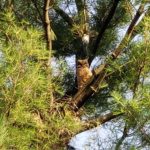
-
This owlet blends into the background of the pine bark trunk.
-
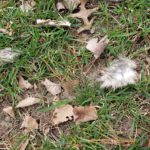
-
Look under trees for owl pellets.
-
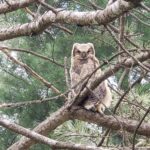
-
Fuzzy owlet































